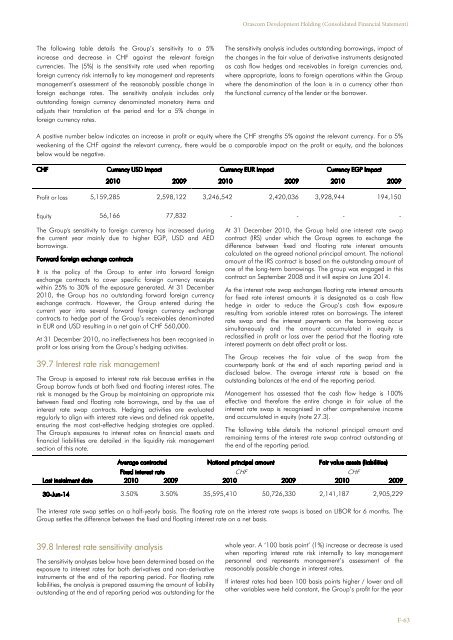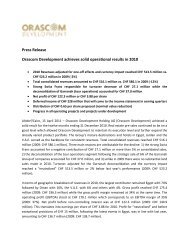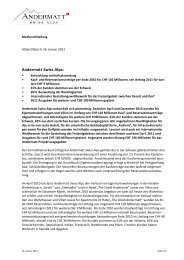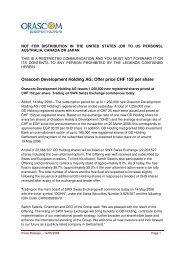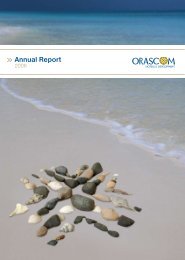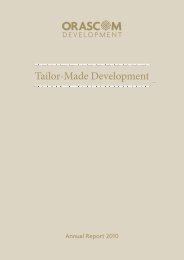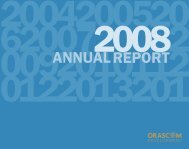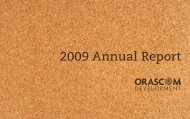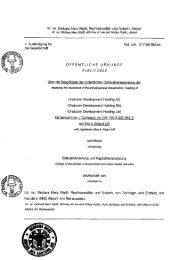FY 2010 Annual Report - Part II - Orascom Development
FY 2010 Annual Report - Part II - Orascom Development
FY 2010 Annual Report - Part II - Orascom Development
You also want an ePaper? Increase the reach of your titles
YUMPU automatically turns print PDFs into web optimized ePapers that Google loves.
<strong>Orascom</strong> <strong>Development</strong> Holding (Consolidated Financial Statement)<br />
The following table details the Group’s sensitivity to a 5%<br />
increase and decrease in CHF against the relevant foreign<br />
currencies. The (5%) is the sensitivity rate used when reporting<br />
foreign currency risk internally to key management and represents<br />
management’s assessment of the reasonably possible change in<br />
foreign exchange rates. The sensitivity analysis includes only<br />
outstanding foreign currency denominated monetary items and<br />
adjusts their translation at the period end for a 5% change in<br />
foreign currency rates.<br />
The sensitivity analysis includes outstanding borrowings, impact of<br />
the changes in the fair value of derivative instruments designated<br />
as cash flow hedges and receivables in foreign currencies and,<br />
where appropriate, loans to foreign operations within the Group<br />
where the denomination of the loan is in a currency other than<br />
the functional currency of the lender or the borrower.<br />
A positive number below indicates an increase in profit or equity where the CHF strengths 5% against the relevant currency. For a 5%<br />
weakening of the CHF against the relevant currency, there would be a comparable impact on the profit or equity, and the balances<br />
below would be negative.<br />
CHF Currency USD Impact Currency EUR Impact Currency EGP Impact<br />
<strong>2010</strong> 2009 <strong>2010</strong> 2009 <strong>2010</strong> 2009<br />
Profit or loss 5,159,285 2,598,122 3,246,542 2,420,036 3,928,944 194,150<br />
Equity 56,166 77,832 - - - -<br />
The Group's sensitivity to foreign currency has increased during<br />
the current year mainly due to higher EGP, USD and AED<br />
borrowings.<br />
Forward foreign exchange contracts<br />
It is the policy of the Group to enter into forward foreign<br />
exchange contracts to cover specific foreign currency receipts<br />
within 25% to 30% of the exposure generated. At 31 December<br />
<strong>2010</strong>, the Group has no outstanding forward foreign currency<br />
exchange contracts. However, the Group entered during the<br />
current year into several forward foreign currency exchange<br />
contracts to hedge part of the Group’s receivables denominated<br />
in EUR and USD resulting in a net gain of CHF 560,000.<br />
At 31 December <strong>2010</strong>, no ineffectiveness has been recognised in<br />
profit or loss arising from the Group’s hedging activities.<br />
39.7 Interest rate risk management<br />
The Group is exposed to interest rate risk because entities in the<br />
Group borrow funds at both fixed and floating interest rates. The<br />
risk is managed by the Group by maintaining an appropriate mix<br />
between fixed and floating rate borrowings, and by the use of<br />
interest rate swap contracts. Hedging activities are evaluated<br />
regularly to align with interest rate views and defined risk appetite,<br />
ensuring the most cost-effective hedging strategies are applied.<br />
The Group's exposures to interest rates on financial assets and<br />
financial liabilities are detailed in the liquidity risk management<br />
section of this note.<br />
At 31 December <strong>2010</strong>, the Group held one interest rate swap<br />
contract (IRS) under which the Group agrees to exchange the<br />
difference between fixed and floating rate interest amounts<br />
calculated on the agreed notional principal amount. The notional<br />
amount of the IRS contract is based on the outstanding amount of<br />
one of the long-term borrowings. The group was engaged in this<br />
contract on September 2008 and it will expire on June 2014.<br />
As the interest rate swap exchanges floating rate interest amounts<br />
for fixed rate interest amounts it is designated as a cash flow<br />
hedge in order to reduce the Group’s cash flow exposure<br />
resulting from variable interest rates on borrowings. The interest<br />
rate swap and the interest payments on the borrowing occur<br />
simultaneously and the amount accumulated in equity is<br />
reclassified in profit or loss over the period that the floating rate<br />
interest payments on debt affect profit or loss.<br />
The Group receives the fair value of the swap from the<br />
counterparty bank at the end of each reporting period and is<br />
disclosed below. The average interest rate is based on the<br />
outstanding balances at the end of the reporting period.<br />
Management has assessed that the cash flow hedge is 100%<br />
effective and therefore the entire change in fair value of the<br />
interest rate swap is recognised in other comprehensive income<br />
and accumulated in equity (note 27.3).<br />
The following table details the notional principal amount and<br />
remaining terms of the interest rate swap contract outstanding at<br />
the end of the reporting period.<br />
Last instalment date<br />
Average contracted Notional principal amount Fair value assets (liabilities)<br />
Fixed interest rate CHF CHF<br />
<strong>2010</strong> 2009 <strong>2010</strong> 2009 <strong>2010</strong> 2009<br />
30-Jun-14 3.50% 3.50% 35,595,410 50,726,330 2,141,187 2,905,229<br />
The interest rate swap settles on a half-yearly basis. The floating rate on the interest rate swaps is based on LIBOR for 6 months. The<br />
Group settles the difference between the fixed and floating interest rate on a net basis.<br />
39.8 Interest rate sensitivity analysis<br />
The sensitivity analyses below have been determined based on the<br />
exposure to interest rates for both derivatives and non-derivative<br />
instruments at the end of the reporting period. For floating rate<br />
liabilities, the analysis is prepared assuming the amount of liability<br />
outstanding at the end of reporting period was outstanding for the<br />
whole year. A ‘100 basis point’ (1%) increase or decrease is used<br />
when reporting interest rate risk internally to key management<br />
personnel and represents management’s assessment of the<br />
reasonably possible change in interest rates.<br />
If interest rates had been 100 basis points higher / lower and all<br />
other variables were held constant, the Group’s profit for the year<br />
F-63


